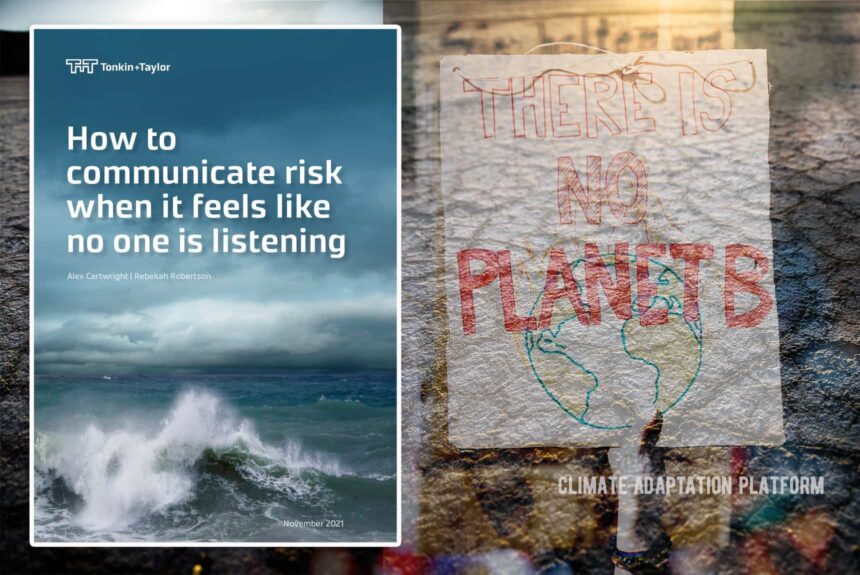The public does not always see or understand the same risk as practitioners or those working in risk management do. This is a well-documented phenomenon known as a misalignment in public perception.
It could also mean improving communication and engagement with the community to ensure that the public and agencies are on the same page in terms of understanding the problem and the risks that come with it.
A paper by Alex Cartwright and Ministry of Foreign Affairs and Trade’s Climate Advisor, Rebekah Robertson, “How to communicate risk when it feels like no one is listening”, discusses climate change’s uncertainty and the critical role of communicating the risk when preparing for long-term climate risk response.
The authors presented the paper during the 2022 IPWEA NZ Conference, which won the prestigious Hynds “Paper of the Year” award.
The paper says that climate change is one of the significant issues our planet faces today, and the hazards and risks it poses are increasing. Some more excerpts from the paper are as follows:
One way to address the risk is to improve resilience in public works. Still, without the buy-in from the community, the benefits of risk management won’t be fully optimized and, in some instances, will even fail to achieve its intended goal. A way to increase community buy-in and lead them to make effective decisions is to ensure they clearly understand that information and its risks and consequences.
An example is how agencies communicate the likelihood or possibility of a particular hazard. Practitioners use the terms Annual Exceedance Probability (AEP) which refers to the probability of a particular hazard occurring in a single year, and an Average Recurrence Interval (ARI) which refers to the average period between an event or also referred to as a return period such as a 1 in a 100-year event.
Using the terms AEP and ARI to explain the chances or frequency of a severe event – for example, an extreme flooding event and the risks and impacts associated with it can sometimes confuse the public.
When communicating about an extreme flooding risk, for instance, to a prospective homeowner in a risk-prone area, the prospective buyer will be provided risk information that says the house could be flooded during a 1 in 100-year event flood (or having a 1% AEP).
The buyer may ascertain that this extreme flooding event will only occur once in the next 100 years. However, the correct information is that the 1% possibility of a flood affecting the house in a given year becomes 26% likelihood during its average 30-year mortgage and 66% likelihood in the next 100 years. This more accurate information will allow the buyer to understand the risks better and thus allow them to make an informed decision.
But even with the improvements in hazard and weather forecasting, these events continue to cause numerous deaths, massive damage, and losses to infrastructure and properties. Typhoon Yolanda/Haiyan, which hit the Philippines in 2013, is an excellent example of this.
Although severe weather warnings were issued days before the super typhoon hit the country and the regions in its direct path were informed days before landfall, the event still caused 6300 deaths and an estimated loss of US$5 billion in damages.
What happened in the Philippines shows that even if the public were provided with clear information, it does not often translate to appropriate action, the paper says.
According to the paper, how people interpret the information provided and how they think the risk will impact their lives is the key to moving them to make decisions.
Risk perception has two psychological dimensions – the cognitive dimension, which relates to what people know and understand about the risk, and the emotional dimension, which relates to how they feel about the risk information.
Understanding the psychological dimensions and their role in moving people to action will allow agencies to refine key messages that resonate better with recipients, helping them make more informed decisions.
For risk communications to be effective, it should use an “impactful” messaging approach that appeals to people’s understanding, knowledge, and emotions.
The paper focuses on natural hazards and climate change risks. It explores the potential causes of this misalignment and highlights better methods to communicate risk, enabling a shift toward true partnerships.
For more information on how to do this, read the entire paper by clicking on the link provided at the “Source” below.
Source:
Cartwright, A., + Robertson, R. (2021). How to communicate risk when no one is listening. IPWEA Conference Paper 2021. Retrieved from https://www.tonkintaylor.co.nz/media/2031/v5-20210707risk-communication-paperreformat.pdf



Leave a Reply